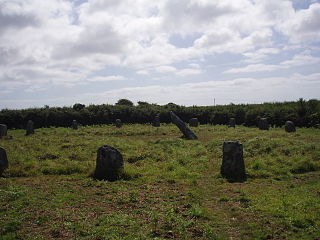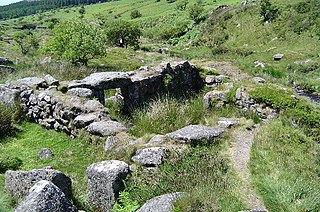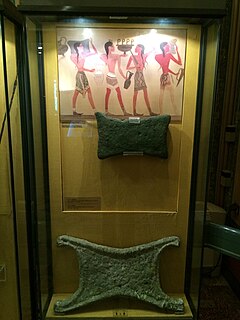Related Research Articles

Bronze is an alloy consisting primarily of copper, commonly with about 12–12.5% tin and often with the addition of other metals and sometimes non-metals, such as phosphorus, or metalloids such as arsenic or silicon. These additions produce a range of alloys that may be harder than copper alone, or have other useful properties, such as strength, ductility, or machinability.

The Bronze Age is a historic period, lasting approximately from 3300 BC to 1200 BC, characterized by the use of bronze, the presence of writing in some areas, and other early features of urban civilization. The Bronze Age is the second principal period of the three-age system proposed in 1836 by Christian Jürgensen Thomsen for classifying and studying ancient societies and history.
The Iron Age is the final epoch of the three-age division of the prehistory and protohistory of humanity. It was preceded by the Stone Age and the Bronze Age (Chalcolithic). The concept has been mostly applied to Iron Age Europe and the Ancient Near East, but also, by analogy, to other parts of the Old World.

Burgh Island is a tidal island on the coast of South Devon in England near the small seaside village of Bigbury-on-Sea. There are several buildings on the island, the largest being the Art Deco Burgh Island Hotel. The other buildings are three private houses, and a pub, the Pilchard Inn.

The Uluburun Shipwreck is a Late Bronze Age shipwreck dated to the late 14th century BC, discovered close to the east shore of Uluburun, Turkey, in the Mediterranean Sea. The shipwreck was discovered in the summer of 1982 by Mehmed Çakir, a local sponge diver from Yalıkavak, a village near Bodrum.

The Erme is a river in south Devon, England. From its source on Dartmoor it flows in a generally southerly direction past some of the best-preserved archaeological remains on the moor. It leaves the moor at the town of Ivybridge and continues southward, passing the settlements of Ermington, Modbury and Holbeton. Near Holbeton it becomes a ria and empties into the English Channel in Bigbury Bay, between the rivers Yealm and Avon.

The history of Cornwall goes back to the Paleolithic, but in this period Cornwall only had sporadic visits by groups of humans. Continuous occupation started around 10,000 years ago after the end of the last ice age. When recorded history started in the first century BCE, the spoken language was Common Brittonic, and that would develop into Southwestern Brittonic and then the Cornish language. Cornwall was part of the territory of the tribe of the Dumnonii that included modern-day Devon and parts of Somerset. After a period of Roman rule, Cornwall reverted to rule by independent Romano-British leaders and continued to have a close relationship with Brittany and Wales as well as southern Ireland, which neighboured across the Celtic Sea. After the collapse of Dumnonia, the remaining territory of Cornwall came into conflict with neighbouring Wessex.

Devon is a county in south west England, bordering Cornwall to the west with Dorset and Somerset to the east. There is evidence of occupation in the county from Stone Age times onward. Its recorded history starts in the Roman period when it was a civitas. It was then a separate kingdom for a number of centuries until it was incorporated into early England. It has remained a largely agriculture based region ever since though tourism is now very important.

Mining in Cornwall and Devon, in the southwest of England, began in the early Bronze Age, around 2150 BC. Tin, and later copper, were the most commonly extracted metals. Some tin mining continued long after the mining of other metals had become unprofitable, but ended in the late 20th century. In 2021, it was announced that a new mine was extracting battery-grade lithium carbonate, more than 20 years after the closure of the last South Crofty tin mine in Cornwall in 1998.

Priddy is a village in Somerset, England in the Mendip Hills, close to East Harptree and 4 miles (6 km) north-west of Wells. It is in the local government district of Mendip.

The Salcombe Cannon wrecksite is close to two other designated wrecksites in the Erme Estuary which the South West Maritime Archaeological Group (SWMAG) was licensed to investigate. In 1992 this group described the Salcombe Cannon site as:

A blowing house or blowing mill was a building used for smelting tin in Cornwall and on Dartmoor in Devon, in South West England. Blowing houses contained a furnace and a pair of bellows that were powered by an adjacent water wheel, and they were in use from the early 14th century until they were gradually replaced by reverberatory furnaces in the 18th century. The remains of over 40 blowing houses have been identified on Dartmoor.

Bouldnor is a hamlet near Yarmouth on the west coast of the Isle of Wight in southern England. It is the location of Bouldnor Battery, a gun battery emplacement.

Bronze Age Britain is an era of British history that spanned from c. 2500–2000 BCE until c. 800 BCE. Lasting for approximately 1,700 years, it was preceded by the era of Neolithic Britain and was in turn followed by the period of Iron Age Britain. Being categorised as the Bronze Age, it was marked by the use of copper and then bronze by the prehistoric Britons, who used such metals to fashion tools. Great Britain in the Bronze Age also saw the widespread adoption of agriculture.

Oxhide ingots are heavy metal slabs, usually of copper but sometimes of tin, produced and widely distributed during the Mediterranean Late Bronze Age (LBA). Their shape resembles the hide of an ox with a protruding handle in each of the ingot’s four corners. Early thought was that each ingot was equivalent to the value of one ox. However, the similarity in shape is simply a coincidence. The ingots' producers probably designed these protrusions to make the ingots easily transportable overland on the backs of pack animals. Complete or partial oxhide ingots have been discovered in Sardinia, Crete, Peloponnese, Cyprus, Cannatello in Sicily, Boğazköy in Turkey, Qantir in Egypt, and Sozopol in Bulgaria. Archaeologists have recovered many oxhide ingots from two shipwrecks off the coast of Turkey.

Tin is an essential metal in the creation of tin-bronzes, and its acquisition was an important part of ancient cultures from the Bronze Age onward. Its use began in the Middle East and the Balkans around 3000 BC. Tin is a relatively rare element in the Earth's crust, with about two parts per million (ppm), compared to iron with 50,000 ppm, copper with 70 ppm, lead with 16 ppm, arsenic with 5 ppm, silver with 0.1 ppm, and gold with 0.005 ppm. Ancient sources of tin were therefore rare, and the metal usually had to be traded over very long distances to meet demand in areas which lacked tin deposits.
Plano-convex ingots are lumps of metal with a flat or slightly concave top and a convex base. They are sometimes, misleadingly, referred to as bun ingots which imply the opposite concavity. They are most often made of copper, although other materials such as copper alloy, lead and tin are used. The first examples known were from the Near East during the 3rd and 2nd Millennia BC. By the end of the Bronze Age they were found throughout Europe and in Western and South Asia. Similar ingot forms continued in use during later Roman and Medieval periods.
Richard James Vincent Larn, OBE is a retired Chief Petty Officer in the Royal Navy, a businessman and maritime history writer who is widely regarded as one of Britain's leading historic shipwreck experts.

Ictis, or Iktin, is or was an island described as a tin trading centre in the Bibliotheca historica of the Sicilian-Greek historian Diodorus Siculus, writing in the first century BC.

The Cornish Bronze Age is an era of the history of Cornwall that spanned the period from c. 2400 BCE to c. 800 BCE. It was preceded by the Cornish Neolithic, and followed by the Cornish Iron Age. It is characterized by the introduction and widespread use of copper and copper-alloy (bronze) weapons and tools.
References
- ↑ Wang, Quanyu; Strekopytov, Stanislav; Roberts, Benjamin W.; Wilkin, Neil (1 March 2016). "Tin ingots from a probable Bronze Age shipwreck off the coast of Salcombe, Devon: Composition and microstructure". Journal of Archaeological Science. 67: 80–92. doi:10.1016/j.jas.2016.01.018. hdl: 10141/607288 . ISSN 0305-4403.
- 1 2 "ERME INGOT - 1000054 | Historic England". historicengland.org.uk. Retrieved 12 October 2020.